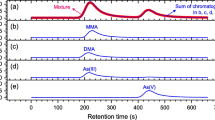Abstract
Traces of cadmium and bismuth in high-purity zinc metal were determined by inductively coupled plasma mass spectrometry (ICP-MS) in combination with flow injection (FI) on-line matrix separation (FI-ICP-MS). The anion-exchange separation method of the potassium iodide (KI) system was applied to the separation of the analytes from the matrix zinc. The analytes, cadmium and bismuth, were adsorbed on the anion-exchange (BIO·RAD AG1-X8) mini-column (1.0 mm i.d.×100 mm bed length), while the matrix zinc can be completely removed from the anion-exchange resin. The analytes were eluted by 2 mol/l HNO3 and directly introduced into the ICP-MS. The detection limits (D.L.) obtained by using a single injection (350 μl) were 0.81 and 0.075 ng g−1 for cadmium and bismuth, respectively. In the case of multi-injection concentration onto the anionexchange mini-column (five injections 350 μl each), the detection limits could be improved to 0.16 and 0.014 ng g−1 for cadmium and bismuth, respectively. The reproducibilities of the single injection and the multi-injection method were satisfactory with a relative standard deviation of less than 5% (at the 10 and 1 ng ml−1 level for the single injection and the multi-injection method, respectively). The method was successfully applied to the determination of trace impurities in four samples of high-purity zinc metal (7 nines grade) and three standard reference materials of high-purity unalloyed zinc samples (from NIST).
Similar content being viewed by others
References
Isshiki M, Tomizono T, Yoshida T, Ohkawa T, Igaki K (1984) J Japan Inst Metals 48:1176–1179
Vieth W, Huneke JC (1991) Spectrochim Acta 46B:137–153
Mcleod CW, Date AR, Cheung YY (1986) Spectrochim Acta 41B:169–174
Seubert A, Meinke R (1994) Fresenius J Anal Chem 348:510–519
Gillson GR, Douglas DJ, Fulford JE, Halligan KW, Tanner SD (1988) Anal Chem 60:1472–1474
Grain JS, Houk RS, Smith FG (1988) Spectrochim Acta 43B:1355–1364
Beer B, Heumann KG (1992) Fresenius J Anal Chem 343:741–745
Beer B, Heumann KG (1993) Anal Chem 65:3199–3203
Nakamura Y, Fukuda T (1990) BUNSEKI KAGAKU 39:T17-T21
Marsh SF, et al. (1978) Los Alamos Scientific Laboratory Report LA-7084 (February)
Author information
Authors and Affiliations
Rights and permissions
About this article
Cite this article
Sayama, Y., Hayashibe, Y. & Fukuda, M. Determination of cadmium and bismuth in high-purity zinc metal by inductively coupled plasma mass spectrometry with on-line matrix separation. Fresenius J Anal Chem 353, 162–166 (1995). https://doi.org/10.1007/BF00322951
Received:
Revised:
Accepted:
Issue Date:
DOI: https://doi.org/10.1007/BF00322951



